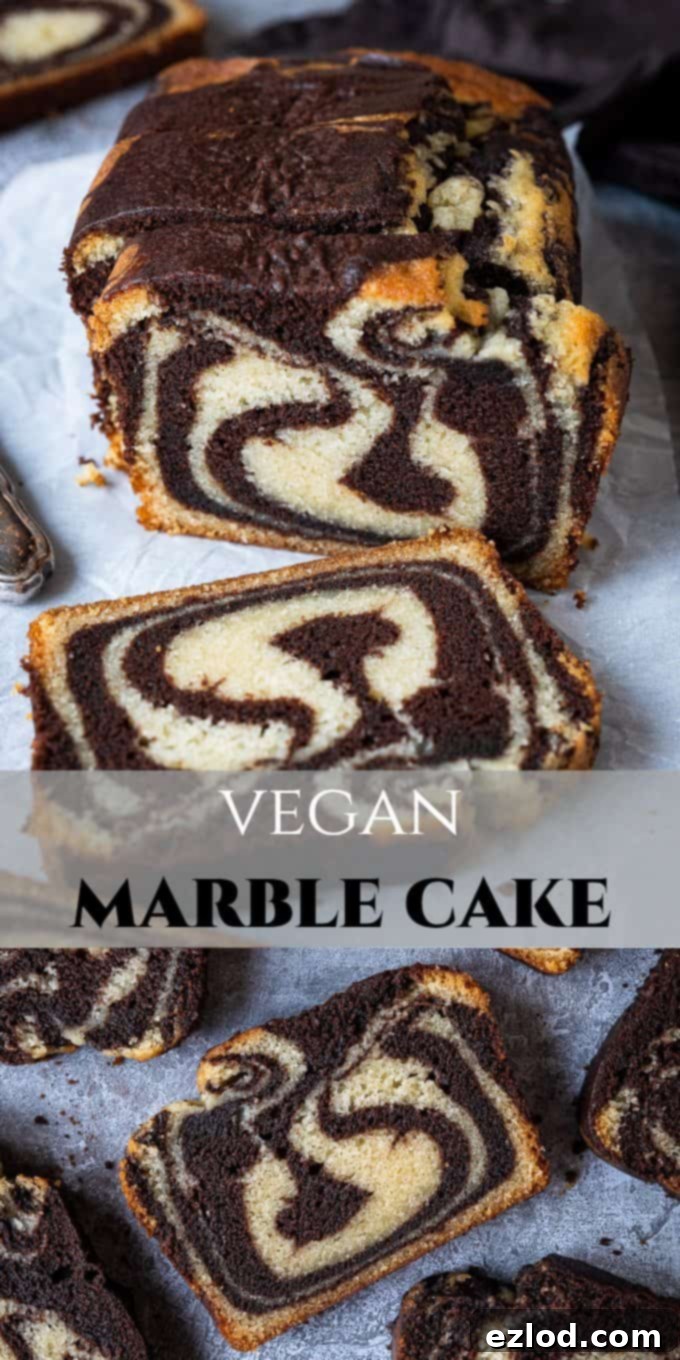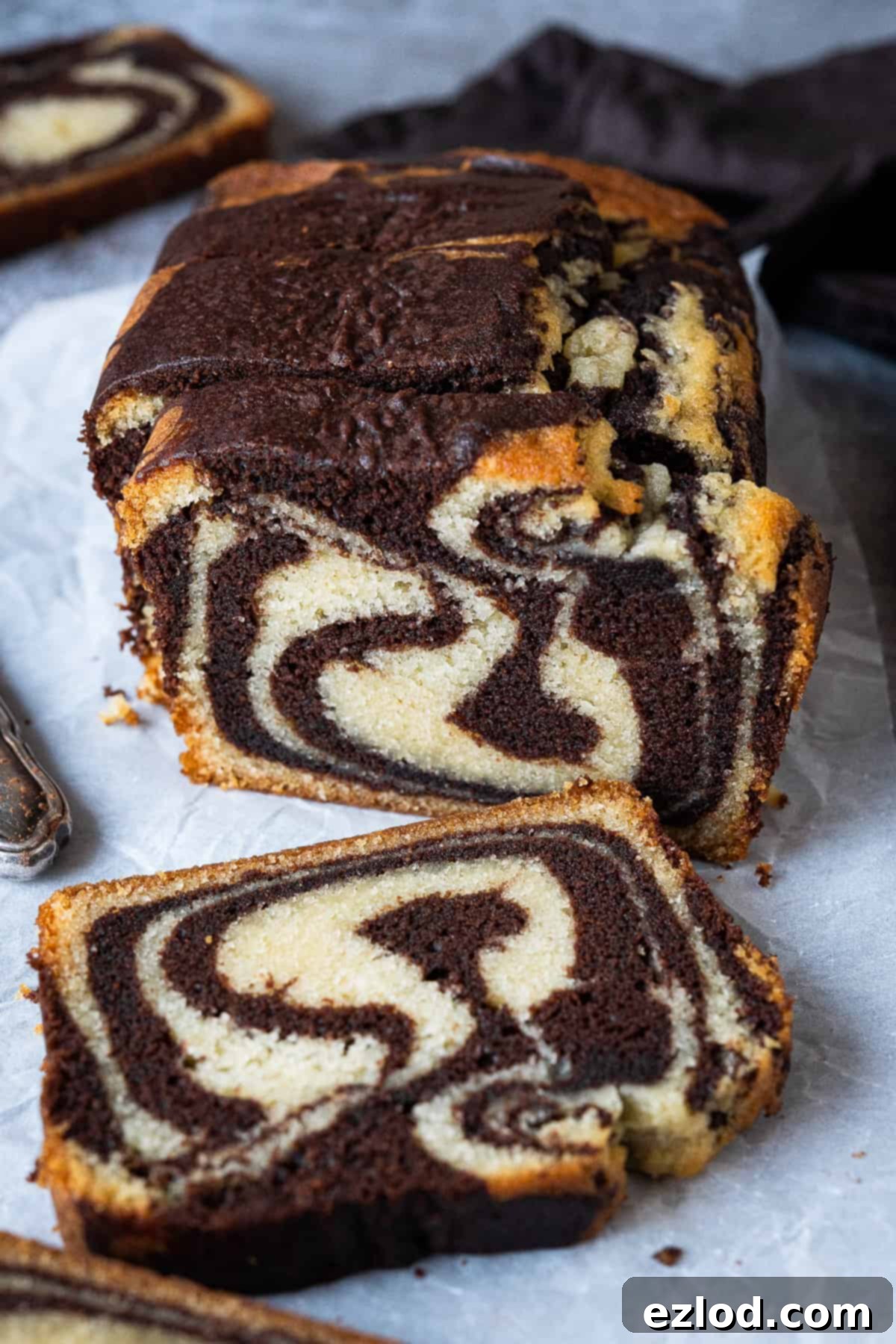Deliciously Moist Vegan Marble Cake: The Ultimate Chocolate & Vanilla Swirl Pound Cake (Eggless & Dairy-Free)
Discover the secret to a perfectly moist, soft, and utterly irresistible vegan marble cake. This stunning chocolate and vanilla pound cake, with its elegant swirls, is completely eggless and dairy-free, making it a fantastic treat for everyone. It’s ideal as an indulgent breakfast, a delightful snack, or a show-stopping dessert!
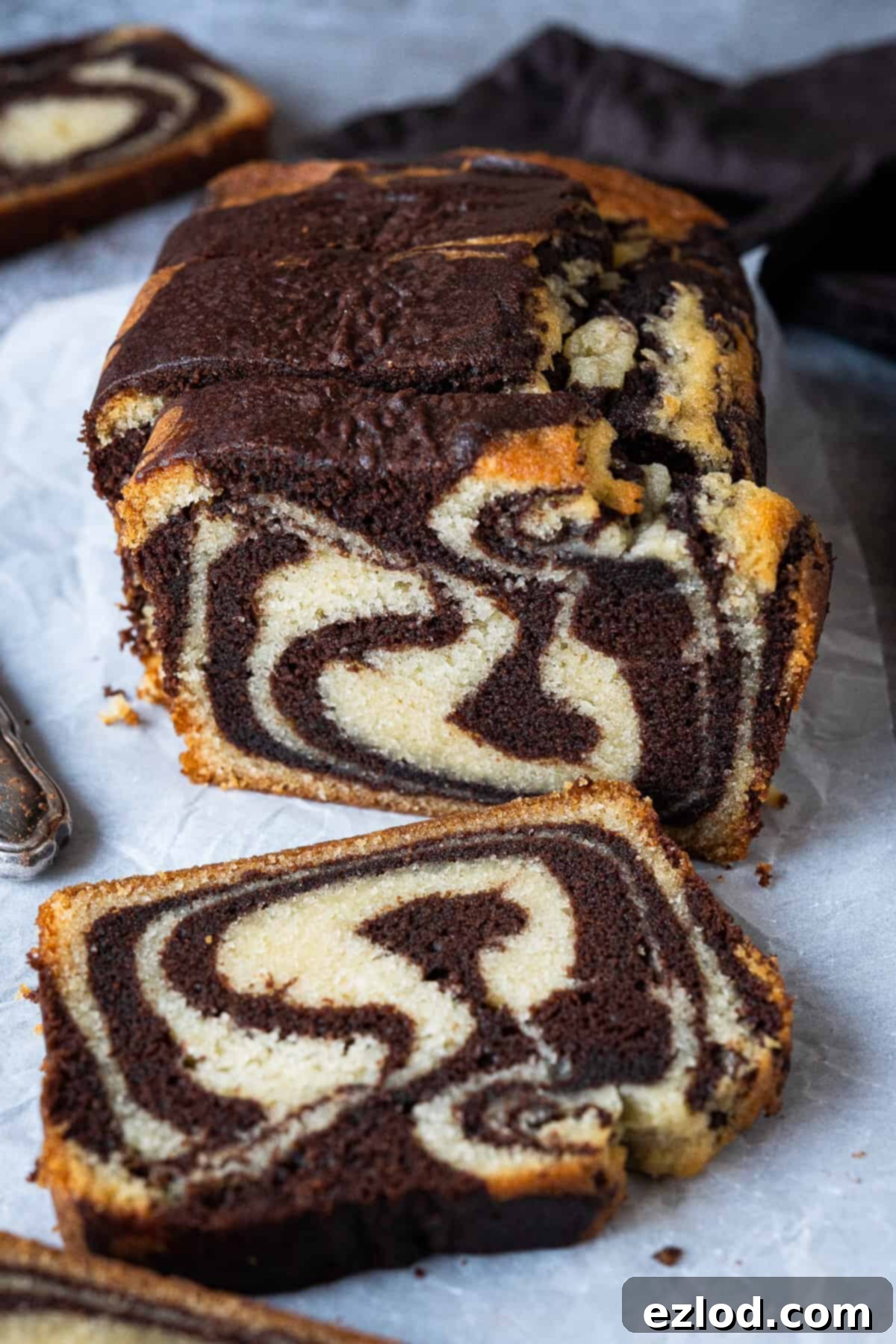
There’s something undeniably captivating about a classic marble cake. The dramatic contrast of dark chocolate and creamy vanilla, intricately swirled together, creates a visual masterpiece that promises a delightful taste experience. This vegan marble cake takes that nostalgic charm and makes it accessible to everyone, ensuring a rich, moist, and tender crumb that’s absolutely bursting with flavor, all while being completely eggless and dairy-free.
Marble cake is an enduring childhood classic, beloved for its distinctive two-toned appearance and comforting pound cake-style texture. Traditionally baked in a loaf tin, it features a blend of two batters – most commonly chocolate and vanilla – artfully combined to create beautiful, unique patterns in every slice. While chocolate and vanilla remain the quintessential combination, variations like chocolate orange or more vibrantly colored versions also exist. This particular recipe focuses on perfecting the timeless chocolate and vanilla duo, offering a simple yet sophisticated vegan adaptation.
Crafting a vegan marble cake that truly rivals its traditional counterpart requires careful consideration of ingredients and technique. Many vegan cakes, especially those designed to be dense and moist like pound cake, can sometimes become tough if overmixed. To counteract this common issue, particularly when incorporating cocoa powder and swirling the batters, this recipe employs the reverse creaming method. This technique is a game-changer for achieving an incredibly soft and tender crumb, making your vegan marble cake a guaranteed success.
The Secret to a Tender Crumb: Reverse Creaming Method Explained
The reverse creaming method might sound advanced, but it’s surprisingly straightforward and highly effective, especially for cakes that require a bit more mixing. Unlike the traditional creaming method where butter and sugar are beaten together first, reverse creaming begins by combining the flour with the fat (in this case, vegan block butter and oil). This initial step coats the flour particles with fat, creating a protective barrier that inhibits gluten development when the wet ingredients are subsequently added and mixed.
By preventing excessive gluten formation, the reverse creaming method ensures a cake with a finer, more even crumb structure and a remarkably tender texture. This is particularly beneficial for marble cakes, where the batter is handled more to incorporate the cocoa and create those beautiful swirls. The result is a cake that remains soft and moist without any risk of becoming dense or chewy. It’s a simple technique that yields profound improvements in your vegan baking, delivering a pound cake consistency that truly melts in your mouth.
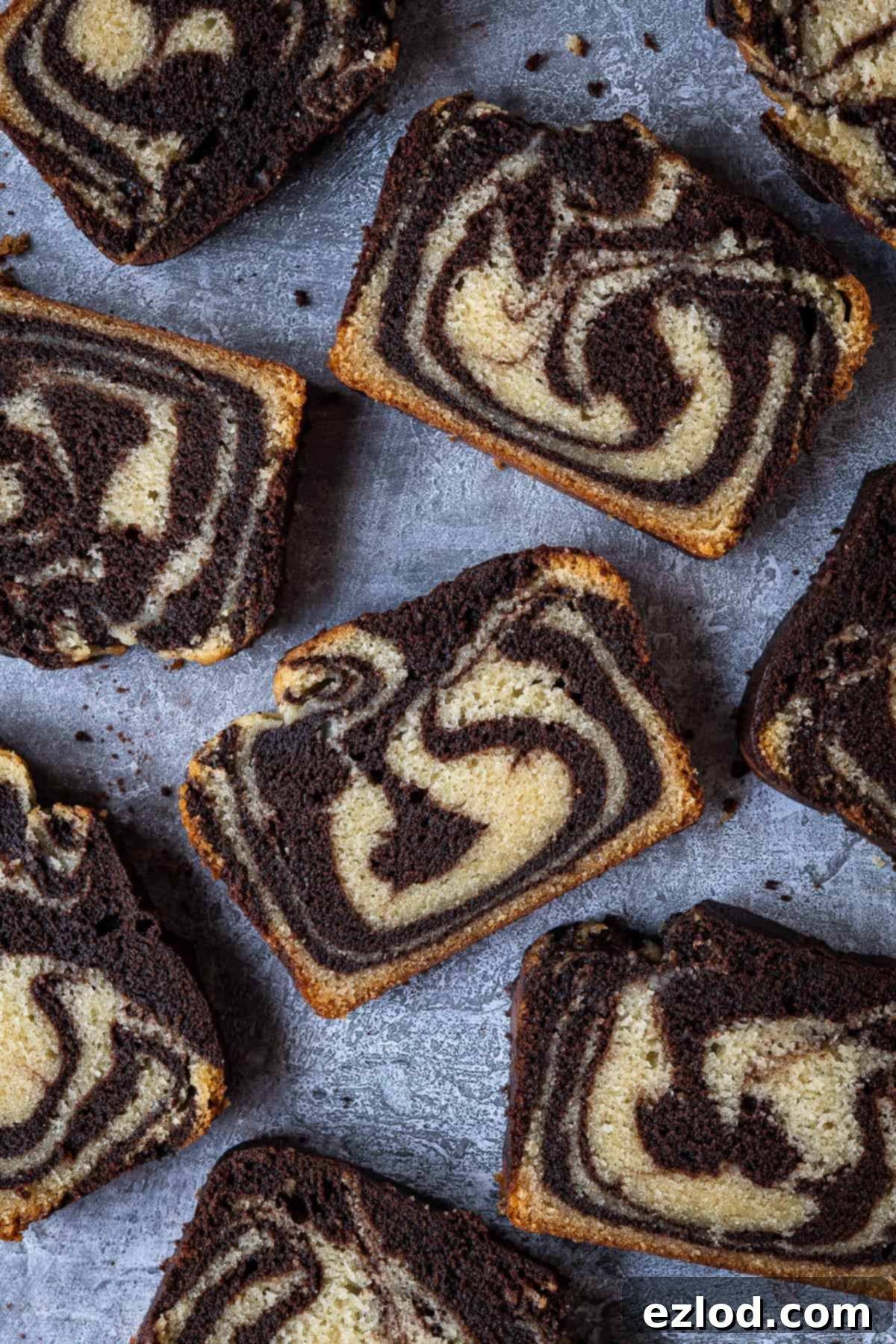
What Ingredients Do I Need for Vegan Marble Cake?
Creating this delicious vegan marble cake relies on a few key ingredients, each playing a vital role in achieving its signature moist, tender, and flavorful profile. Here’s a closer look at what you’ll need and why:
- Silken Tofu: This is a superstar egg replacer for dense, moist cakes like pound cake. After extensive testing, silken tofu has proven to be unparalleled in replicating the desired texture—dense, yet incredibly moist, soft, and tender. While it’s not a common egg replacer for all cakes, it excels here, contributing significantly to the cake’s structure and richness. Ensure you use firm silken tofu, the shelf-stable variety, not the refrigerated type, and drain any excess liquid before blending.
- Unsweetened Non-Dairy Milk: Unsweetened soy milk is generally recommended for baking due to its higher protein content, which contributes to better structure. However, any unsweetened non-dairy milk you have on hand, such as almond, oat, or cashew milk, will work perfectly well in this recipe.
- Vinegar (Cider or White Wine Vinegar): A touch of vinegar is crucial for activating the bicarbonate of soda (baking soda), creating an acidic environment that aids in the cake’s rise and contributes to its light texture. Lemon juice can also be used as an effective substitute.
- Vanilla Extract: A generous amount of good quality vanilla extract is essential for enhancing the cake’s flavor, particularly the vanilla portion. Always opt for pure vanilla extract over imitation vanilla essence for the best aromatic and taste profile.
- Cornflour (Cornstarch): Incorporating cornflour helps to achieve a lovely soft and tender texture in the cake. If you don’t have cornflour, you can simply substitute it with an equal amount of plain (all-purpose) flour. For those with cake flour, you can omit both the plain flour and cornflour and use cake flour entirely.
- Plain (All-Purpose) Flour: This forms the primary structure of the cake. When combined with cornflour, it strikes a perfect balance for the desired crumb. If using cake flour, you’ll replace both plain flour and cornflour with it.
- Cocoa Powder: For the rich chocolate swirls, Dutch-processed cocoa powder is ideal. In many regions, including the UK, standard supermarket cocoa powder is typically Dutch-processed, offering a deep, mellow chocolate flavor and a darker color.
- Baking Powder and Bicarbonate of Soda (Baking Soda): These leavening agents are indispensable for ensuring your cake rises beautifully, resulting in a light and airy texture.
- Vegan Block Butter: For an optimal cake texture, it is imperative to use a high-quality vegan block butter or margarine. These solid blocks, often foil-wrapped, have a lower water content compared to spreadable margarines found in tubs. The higher water content in tub spreads can negatively impact the cake’s texture. Brands like Naturli Vegan Block, Stork, Vitalite, or Tormor blocks are excellent choices. While spreadable margarine can be used in a pinch, block butter is highly recommended for superior results.
- Neutral Oil: The addition of a neutral-flavored oil alongside the vegan butter contributes to an exceptionally moist and soft cake. Sunflower, vegetable, canola, or a mild olive oil are all suitable options that won’t overpower the cake’s delicate flavors.
- Caster (Superfine) Sugar: Golden caster sugar adds a subtle depth of flavor, but white caster sugar works equally well. If you only have granulated sugar, a quick blitz in a blender can transform it into superfine caster sugar, which dissolves more easily into the batter for a smoother finish.
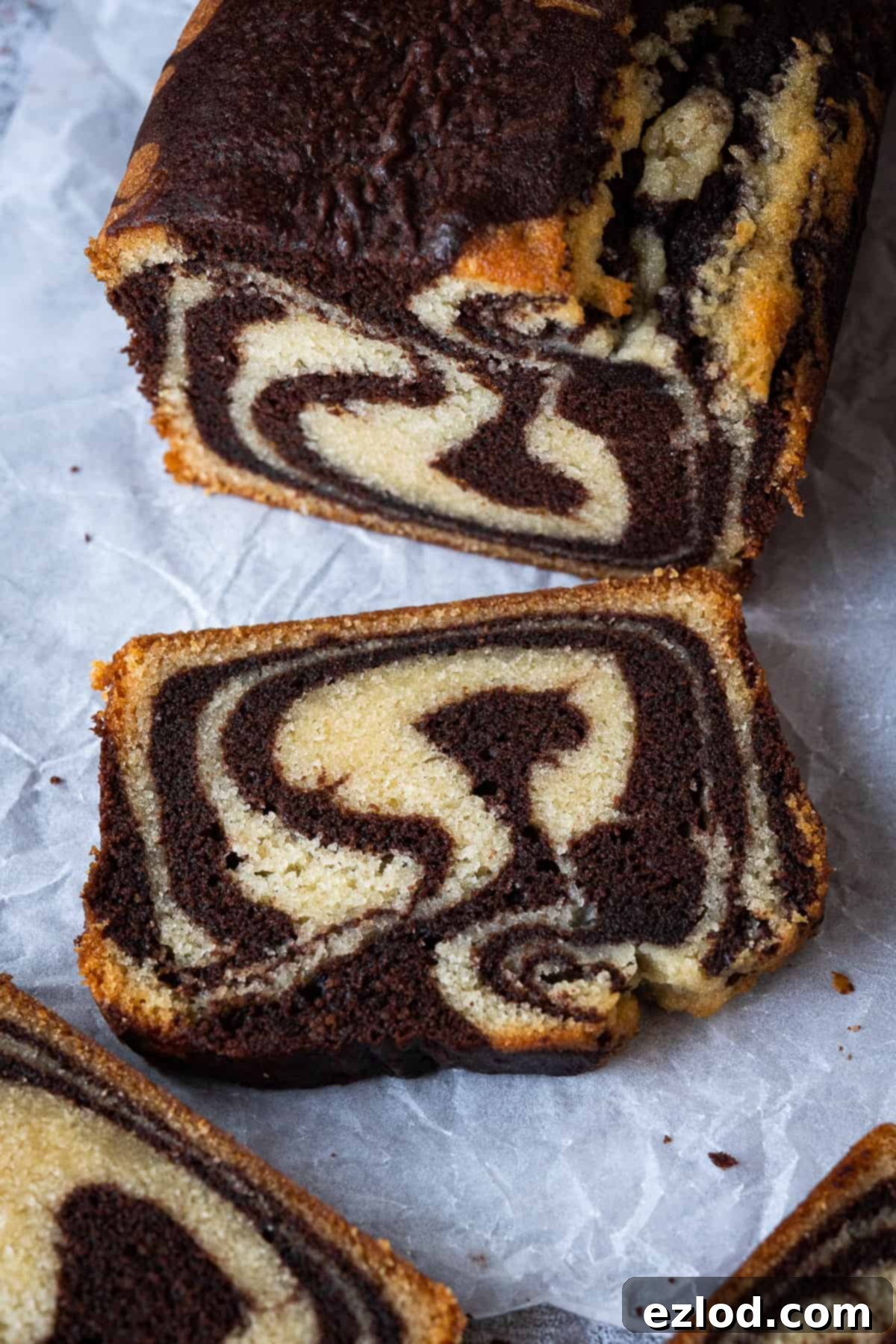
How to Make Delicious Vegan Marble Cake: Step-by-Step
Get ready to create a stunning and delicious vegan marble cake with these easy-to-follow instructions. Remember, precise measurements, especially weighing ingredients in grams, will ensure the best results.
(For a concise ingredient list and full instructions, please refer to the recipe card below.)
Preparation Steps:
- Preheat Oven & Prepare Tin: Start by preheating your oven to 180°C (160° fan/350°F/gas mark 4). Lightly grease an approximately 11.5 x 21.5 cm (4.5 x 8.5 inch) loaf tin (this is typically a 2lb loaf tin) and line it with a strip of baking parchment, allowing some overhang on the longer sides to easily lift the cake out later.
- Prepare Cocoa Paste: In a medium-sized bowl, place the cocoa powder. Whisk in the boiling water until you achieve a smooth, lump-free paste. Set this aside for later use. This ensures the cocoa is fully hydrated and integrates smoothly into the chocolate batter.
Creating the Batter:
- Blend Wet Ingredients: In a blender, combine the silken tofu (make sure any excess liquid is drained), non-dairy milk, vanilla extract, and vinegar. Blend until the mixture is completely smooth and creamy. If you don’t have a blender, a large jug and a stick blender work perfectly.
- Combine Dry Ingredients: In a large mixing bowl, whisk together the plain flour, cornflour, baking powder, bicarbonate of soda, salt, and caster sugar until well combined. This ensures an even distribution of leavening agents and flavor.
- Add Fats to Dry Ingredients (Reverse Creaming): Pour the melted vegan block butter and neutral oil into the bowl with the dry ingredients. Stir thoroughly until no dry patches of flour remain and the mixture resembles wet sand. This crucial step, part of the reverse creaming method, coats the flour particles and helps prevent over-development of gluten, leading to a softer, more tender cake.
- Combine Wet and Dry: Gradually whisk the blended wet ingredients into the dry mixture until a smooth, uniform batter forms. Be careful not to overmix at this stage; mix just until everything is incorporated.
Marbling the Batter:
- Create Chocolate Batter: Measure out 500g of the vanilla batter (which is just under half of the total batter) into the bowl containing the prepared cocoa paste. Stir gently until the chocolate is fully incorporated and the batter is a smooth, even chocolate color.
- Layer the Batters: Begin spooning the batters into your prepared loaf tin. Start by spooning approximately one-third of one color (either vanilla or chocolate) into the tin. Then, spoon about one-third of the other color on top. Don’t worry about neatness; imperfect layers create more beautiful swirls. Repeat this process two more times, alternating colors, until you have three distinct layers of each color.
- Swirl for Marble Effect: Once all the batter is in the tin, take a skewer or a knife and drag it through the batter a couple of times. Use a gentle S-shape or zigzag motion. The key is to swirl just enough to create the marble effect, not to completely mix the colors. Over-swirling will result in a uniform, muddy color rather than distinct swirls. A few deliberate passes are all you need.
Baking and Cooling:
- Bake the Cake: Place the loaf tin in the preheated oven and bake for 60-75 minutes. The cake is done when a skewer inserted into the center comes out clean. If you notice the top browning too quickly towards the end of baking, you can loosely cover it with a piece of tin foil to prevent further darkening.
- Cool Completely: Allow the cake to cool in the tin for about 20 minutes after baking. This helps it firm up and prevents it from breaking. After 20 minutes, gently turn the cake out onto a wire rack and let it cool completely before attempting to slice it. Slicing while warm can cause it to crumble.
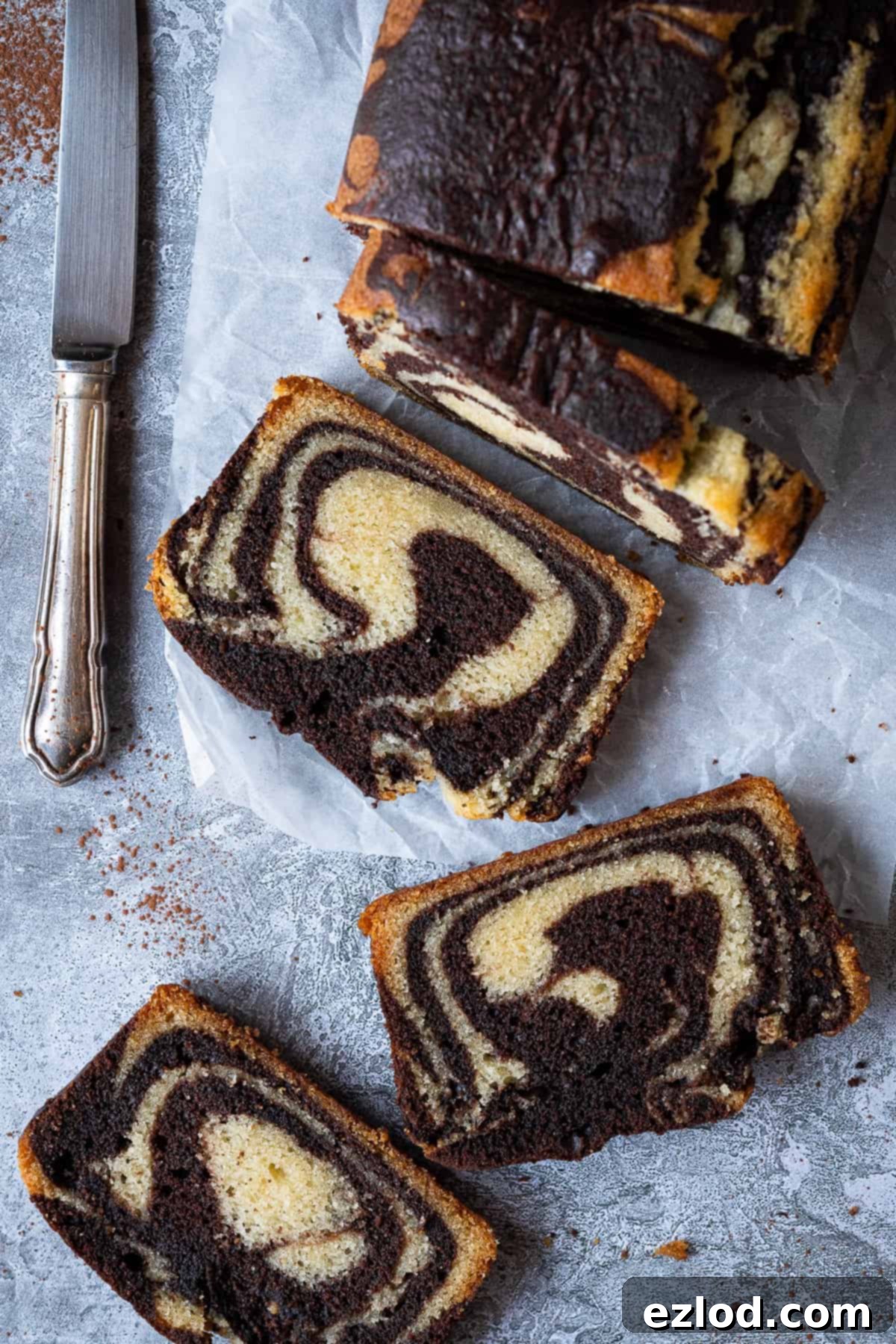
Top Tips for Vegan Marble Cake Perfection:
Achieving the perfect vegan marble cake is easier than you think with these expert tips:
- Accurate Measurements Are Key: Baking is a science, and precision is paramount. Always weigh your ingredients using gram measurements on a digital scale rather than relying on cup conversions. Cup measurements can vary significantly, impacting the final texture and consistency of your cake. Following gram measurements will guarantee the best results every time.
- Choose the Right Vegan Butter: As highlighted in the ingredients section, using a vegan block butter or margarine is crucial. These solid fats have the ideal composition for baking, ensuring the correct texture. Avoid spreadable tub margarines, which contain too much water and can lead to a less desirable cake texture.
- Select the Correct Silken Tofu: For this recipe, you need firm silken tofu. This is the shelf-stable variety typically found in the “Asian” aisle or next to canned beans in UK supermarkets, not the soft, refrigerated kind. Its firm consistency provides the best structure and moisture for pound cakes.
- Room Temperature Ingredients: Ensure all your liquid ingredients, especially the non-dairy milk, are at room temperature. This helps them emulsify properly with the fats and sugars, resulting in a smoother, more uniform batter and a better rise. Take them out of the fridge at least a couple of hours before you plan to bake.
- Gentle Swirling: When marbling the batters, resist the urge to over-swirl. A few passes with a skewer or knife are sufficient to create beautiful, distinct swirls. Overmixing at this stage will blend the colors too much, resulting in a muddy appearance rather than clear marble patterns.
- Elevate with Toppings: While this cake is absolutely delicious on its own, it also serves as a fantastic base for various toppings. A rich chocolate ganache would be a decadent addition, or a simple dusting of powdered sugar could provide an elegant finish. Feel free to experiment!
How to Store Vegan Marble Cake:
To keep your vegan marble cake fresh and delicious, store it in an airtight container at room temperature. It will retain its wonderful flavor and moistness for approximately three days. Beyond that, it might start to lose its freshness and become a bit stale.
Can I Freeze Vegan Marble Cake?:
Absolutely! This vegan marble cake freezes exceptionally well, making it perfect for meal prep or enjoying a slice whenever a craving strikes. You can freeze it either whole or in individual slices, depending on your preference. Ensure the cake is thoroughly wrapped in plastic wrap and then again in aluminum foil to prevent freezer burn. It can be frozen for up to three months. To enjoy, simply allow it to defrost at room temperature.
More Delicious Vegan Loaf Cakes to Try:
If you loved this vegan marble cake, be sure to explore these other fantastic vegan loaf cake recipes:
- Vegan Lemon Pound Cake
- Vegan Carrot Loaf Cake
- Easy Vegan Banana Bread
- Vegan Pumpkin Bread
- Ultimate Vegan Lemon Drizzle Cake
- Vegan Courgette Cake
- Sweet Potato Bread with Pecan Streusel
- Vegan Biscoff Banana Bread
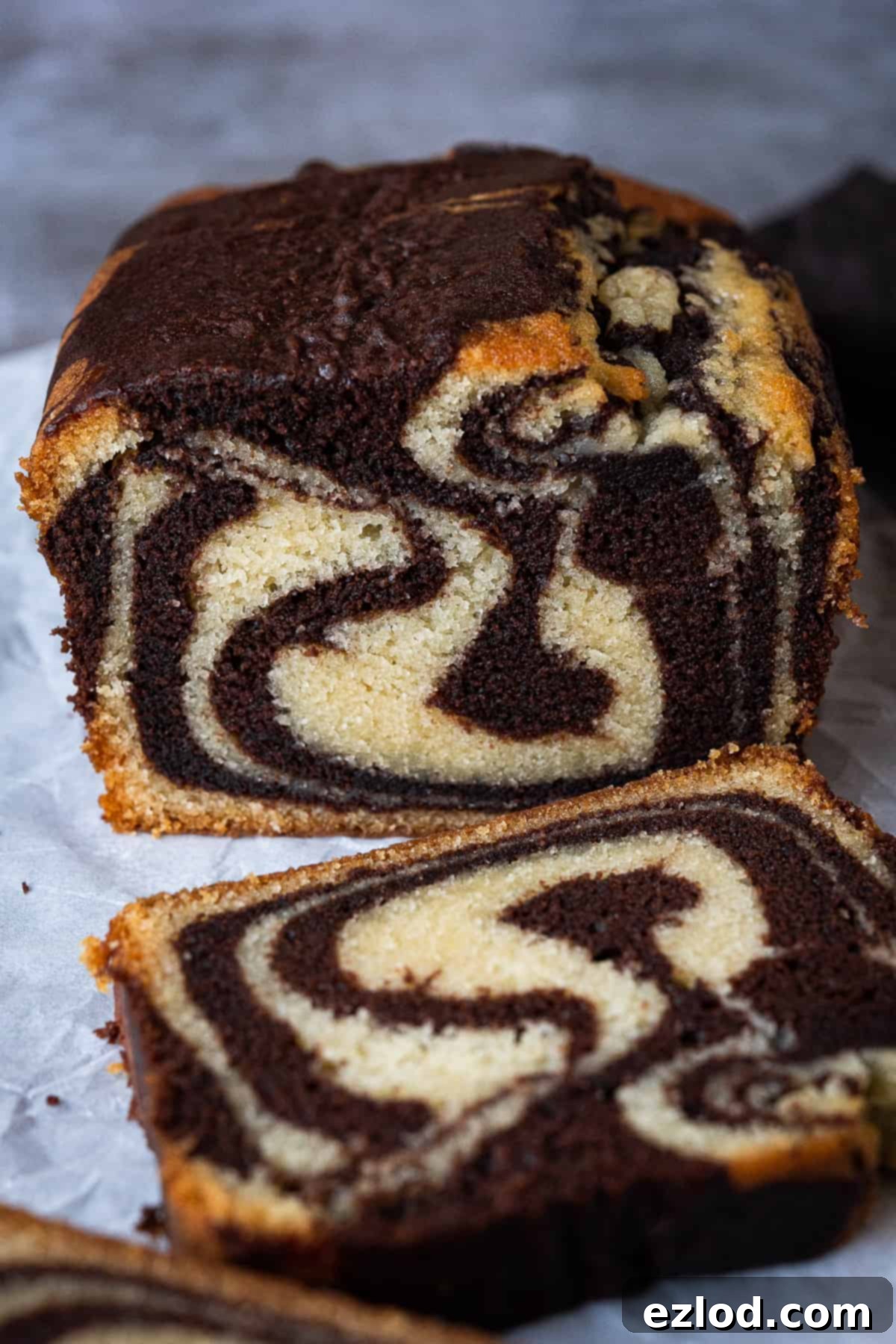
If you tried this recipe and loved it, please let me know how it went! Rate it, leave a comment below, or tag @domestic_gothess on Instagram and use the hashtag #domesticgothess. Your feedback is greatly appreciated!
*All images and content on Domestic Gothess are copyright protected. If you want to share this recipe, please do so by using the share buttons provided. Do not screenshot or post the recipe or content in full.*
Vegan Marble Cake
Dessert, Snack
Baking
Cake, Vegan, Marble
20
1
5
1
25
10 people
Domestic Gothess
Ingredients
- 30 g (3 Tbsp) cocoa powder
- 4 Tbsp boiling water
- 120 g silken tofu* excess liquid drained off
- 200 ml (½ + ⅓ cup) unsweetened non-dairy milk (soy is best)
- 1 Tbsp vanilla extract
- 1 ½ tsp cider or white wine vinegar (or lemon juice)
- 240 g (2 cups) plain (all-purpose) flour
- 25 g (2 ½ Tbsp) cornflour (cornstarch)**
- 1 ½ tsp baking powder
- ¼ tsp bicarbonate of soda (baking soda)
- ½ tsp salt
- 275 g (1 ⅓ cups) caster (superfine) sugar
- 120 g (½ cup) vegan block butter melted
- 45 ml (3 Tbsp) neutral oil (sunflower/vegetable/canola/mild olive)
Instructions
-
Preheat the oven to 180°C/160°fan/350°F/gas mark 4. Grease an approx 11.5 x 21.5 cm / 4.5 x 8.5 in loaf tin (2lb loaf tin) and line with a strip of baking parchment.
-
Place the cocoa powder in a large bowl and whisk in the boiling water to make a smooth paste. Set aside.
-
Place the silken tofu, milk, vanilla extract and vinegar in a blender and blitz until smooth. (A stick blender in a large jug works well).
-
Place the plain flour, cornflour, baking powder, bicarbonate of soda, salt and sugar in a large bowl and whisk to combine.
-
Add the melted butter and oil to the dry ingredients and stir until no dry patches remain (this is the reverse creaming method).
-
Gradually whisk the wet ingredients into the dry to form a smooth batter.
-
Measure 500g of the batter (just under half) into the cocoa mixture and stir until smooth to create the chocolate batter.
-
Spoon ⅓ of one color into the prepared tin, then ⅓ of the other color on top. Repeat two more times to create three layers of each color.
-
Drag a skewer or knife through the batter a couple of times to swirl the colors together. Do not over-swirl.
-
Bake the cake for 60-75 minutes until a skewer inserted into the center comes out clean. Loosely cover with foil if the top browns too much.
-
Leave the cake to cool in the tin for 20 minutes, then turn it out onto a wire rack to cool completely before slicing.
Notes
- For best results, weigh ingredients in grams with a digital scale for accuracy.
- *Use firm, shelf-stable silken tofu. Do not substitute with refrigerated soft tofu.
- **If you have cake flour, use 265g in place of both plain flour and cornflour.
- This recipe is adapted using elements from my vegan lemon pound cake and Izy Hossack’s marble cake recipe, particularly the reverse creaming method.
